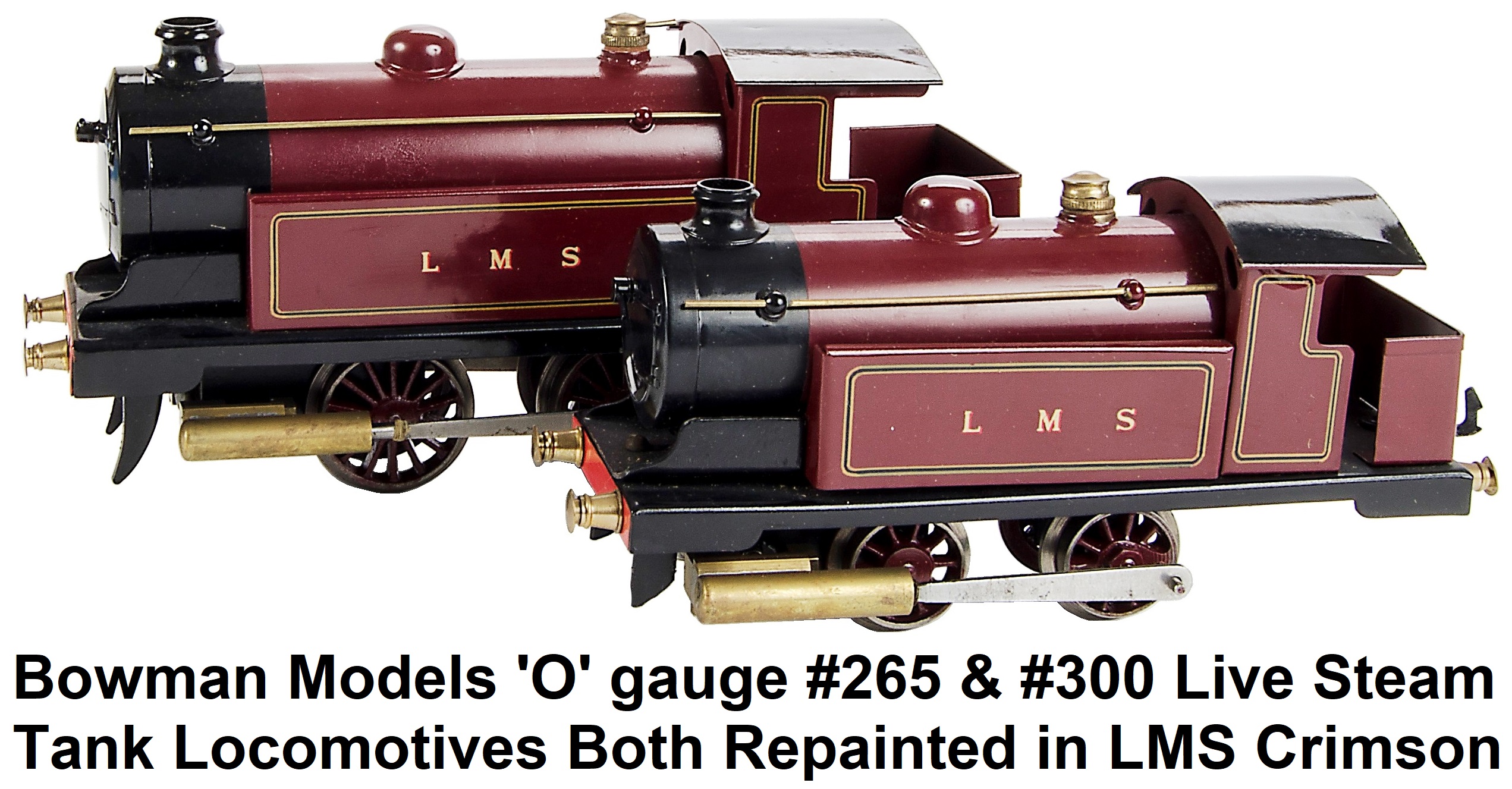 Bowman Models of Dereham, Norfolk, England, was founded in 1926 by Geoffrey Bowman Jenkins. Jenkins began his career in
model steam establishing a partnership with Hobbies Ltd. Engineering & Manufacturing, a long standing supplier of model
making supplies in Dereham, in 1923. The first Bowman Models product was a line of live steam powered boats, with Hobbies
Ltd. building the hull, and Geoffrey Bowman Jenkins producing the steam plant. Bowman Models soon expanded out into
stationary steam engines, around 1927. They also introduced 4 live steam locomotive models shortly thereafter. The company
continued to produce their range of steam-powered models between the World Wars, under the directorship of Geoffrey Bowman
Jenkins and later by Bernard A. Smart. Jenkins supplied models and engines to Hobbies Ltd. from around 1923 to around 1935,
and then went out on his own. Gamages, the famous department store in Holborn, London, trading between 1878 and 1972, and
well known for its toy and hardware departments, advertised having bought up liquidated stock of Bowman engines in 1950-51,
so presumably the company exited around that time.
Bowman Models of Dereham, Norfolk, England, was founded in 1926 by Geoffrey Bowman Jenkins. Jenkins began his career in
model steam establishing a partnership with Hobbies Ltd. Engineering & Manufacturing, a long standing supplier of model
making supplies in Dereham, in 1923. The first Bowman Models product was a line of live steam powered boats, with Hobbies
Ltd. building the hull, and Geoffrey Bowman Jenkins producing the steam plant. Bowman Models soon expanded out into
stationary steam engines, around 1927. They also introduced 4 live steam locomotive models shortly thereafter. The company
continued to produce their range of steam-powered models between the World Wars, under the directorship of Geoffrey Bowman
Jenkins and later by Bernard A. Smart. Jenkins supplied models and engines to Hobbies Ltd. from around 1923 to around 1935,
and then went out on his own. Gamages, the famous department store in Holborn, London, trading between 1878 and 1972, and
well known for its toy and hardware departments, advertised having bought up liquidated stock of Bowman engines in 1950-51,
so presumably the company exited around that time.
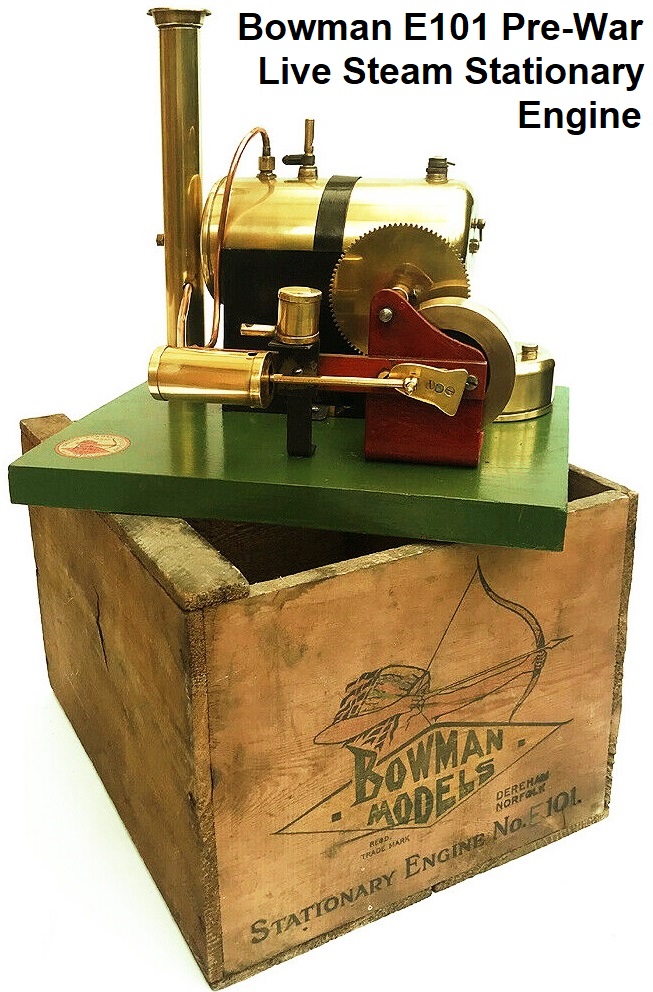 Jenkins had started out making and selling toys in London. After Hobbies Ltd. had to stop using their
original German suppliers of steam engines, a search brought Bowman Jenkins to their attention, and he was persuaded to move
up to to Norfolk around 1923, and assemble boats and manufacture steam engines that Hobbies Ltd. could then advertise and
sell through the "Hobbies Weekly". At first the steam driven models were sold as Hobbies products, then marketed under the
name Hobbies-Bowman, and finally in 1926 as just Bowman Models products. Bowman seems to have parted company with Hobbies Ltd.
completely by 1935 in order to pursue other manufacturing interests, including a spring-powered gramophone, at which point
Hobbies brought in Geoffrey Malins (Malins Models, Mamod) as a replacement.
Jenkins had started out making and selling toys in London. After Hobbies Ltd. had to stop using their
original German suppliers of steam engines, a search brought Bowman Jenkins to their attention, and he was persuaded to move
up to to Norfolk around 1923, and assemble boats and manufacture steam engines that Hobbies Ltd. could then advertise and
sell through the "Hobbies Weekly". At first the steam driven models were sold as Hobbies products, then marketed under the
name Hobbies-Bowman, and finally in 1926 as just Bowman Models products. Bowman seems to have parted company with Hobbies Ltd.
completely by 1935 in order to pursue other manufacturing interests, including a spring-powered gramophone, at which point
Hobbies brought in Geoffrey Malins (Malins Models, Mamod) as a replacement.
The use of functional steam power meant that Bowman's core range wasn't extensive, and their steam-powered
pieces were engineered for simplicity and reliability, with a minimum of fancy ornamentation. Simplicity was the goal, as
models featured a huge pot boiler driving twin oscillating engines that drove wheels directly. As well as producing
stationary steam engines for driving Meccano models, the company also produced the steam
locomotives, rolling stock, rubber-band-powered model aeroplanes, and clockwork, rubber-drive and steam-powered
speedboats. The Bowman live steam engine models were the #234 4-4-0 tender locomotive, #265 0-4-0 saddle tank locomotive,
#300 0-4-0 tank locomotive, #410 0-4-0 Junior tank locomotive, #832 Bath Tub Griding Stone, Demon, Peggy, Eagle, Swallow,
Aeroboat, Seahawk, and Snipe Steam Launches, E101 stationary steam engine, E135 stationary steam engine, E158 stationary
steam engine, E167 stationary steam engine, M101 stationary steam engine, M122 stationary steam engine, M122D stationary
steam engine, M130 stationary steam engine, M135 stationary steam engine, M140 stationary steam engine, M158 stationary
steam engine, M167 stationary steam engine, M175 stationary steam engine, and M180 stationary steam engine.
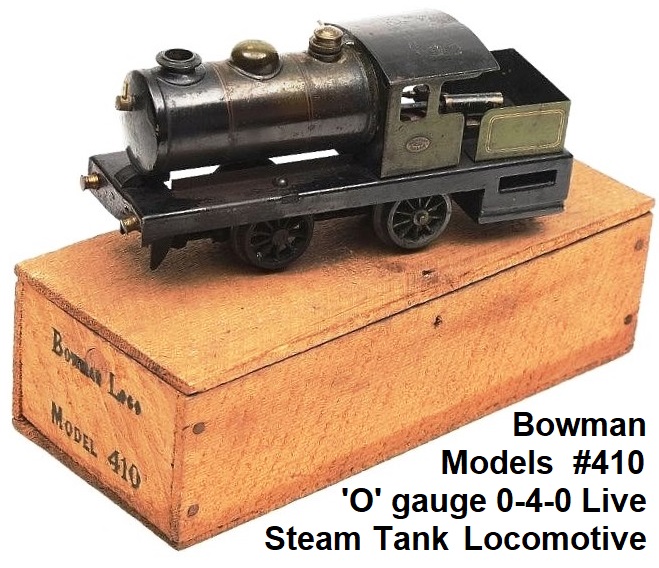 Bowman's small range of model railway equipment was distinguished by it's deliberately oversized 1 gauge
superstructure running on 'O' gauge sized track. Since Bowman's locomotives were all steam-powered, this mix of scales
allowed the combination of brutishly robust, solid-running and almost indestructable steam locomotives with the most
common inter-war era track size. The locomotives were huge in size, very simply made with two oscillating cylinders and
a burner with six wicks. The oversized locos and rolling stock (on the
company's heavy-duty weatherproof 'O' gauge track) was particularly useful for garden railways where space was limited,
since it combined a relatively small and flexible track gauge (with fairly tight turning circles) with trains that would
normally be associated with larger and more awkward track. Steam power also meant that a Bowman garden railway didn't
care too much about whether there was a tiny amount of dirt on the rails that might break the contact of an electrically
powered locomotive, or whether there were any electrical shorts - a Bowman model railway could even run in the rain!
Bowman's small range of model railway equipment was distinguished by it's deliberately oversized 1 gauge
superstructure running on 'O' gauge sized track. Since Bowman's locomotives were all steam-powered, this mix of scales
allowed the combination of brutishly robust, solid-running and almost indestructable steam locomotives with the most
common inter-war era track size. The locomotives were huge in size, very simply made with two oscillating cylinders and
a burner with six wicks. The oversized locos and rolling stock (on the
company's heavy-duty weatherproof 'O' gauge track) was particularly useful for garden railways where space was limited,
since it combined a relatively small and flexible track gauge (with fairly tight turning circles) with trains that would
normally be associated with larger and more awkward track. Steam power also meant that a Bowman garden railway didn't
care too much about whether there was a tiny amount of dirt on the rails that might break the contact of an electrically
powered locomotive, or whether there were any electrical shorts - a Bowman model railway could even run in the rain!
 The Bowman Models #234 was the cornerstone of the line. It was a steam powered 4-4-0 model dubbed the Express Steam
Locomotive. It was promoted as the model that made Bowman famous throughout the world. The tender was catalogued as
the #250. Ads stated that the #234 could pull a train of 6 large coaches for 1½ miles every time it is filled
accomplishing a non-stop run of 40 minutes complete with steam puffing from the stack. It featured a solid drawn brass
boiler, Bowman safety valve, overflow plug for filling to the correct level, steam exhausts through the chimney stack, solid
drawn brass cylinders with a 3/8" x 7/8" stroke, brass pistons with grooved oil rings, special felt oiling pads for
lubrication, steel frame, turned cast steel wheels with steel axles, a safety type lamp for methylated spirit, and asbestos
wicks. Wick covers were supplied for cutting out burners at an extra cost. The #234 engine with tender measured 20" long and
weighed 5 lbs. It came in a strong wood box, with a tube of Bowman Loco oil, a filling funnel, and a full set of instructions
with hints on how to run the loco. The #234 loco was priced at £30, while the #250 tender was £7/6 extra. It was
offered in lined apple green and black Flying Scotsman L.N.E.R. #4472 markings, but it is believed that Bowman's model #234
was actually modelled after the L.N.E.R. #234 Yorkshire 4-4-0 locomotive. However, even though it had a different wheel
arrangement, during this period, the Flying Scotsman was a more popular locomotive, so producing a #4472 version might have
been a more sensible marketing move. The company also produced several other versions of the #234, including one with
crimson and black L.M.S. markings, one with green L.N.E.R. markings but numbered #234, and one with L.M.S. black with smoke
deflectors. The separate sale #250 6-wheel tender allowed the loco to be utilized with existing tenders from other
manufacturers, thus facilitating having mixed consists of rolling stock. The #250 tender was offered in paint schemes of the
four main Railway groups, L.N.E.R, L.M.S., G.W.R. and S.R.
The Bowman Models #234 was the cornerstone of the line. It was a steam powered 4-4-0 model dubbed the Express Steam
Locomotive. It was promoted as the model that made Bowman famous throughout the world. The tender was catalogued as
the #250. Ads stated that the #234 could pull a train of 6 large coaches for 1½ miles every time it is filled
accomplishing a non-stop run of 40 minutes complete with steam puffing from the stack. It featured a solid drawn brass
boiler, Bowman safety valve, overflow plug for filling to the correct level, steam exhausts through the chimney stack, solid
drawn brass cylinders with a 3/8" x 7/8" stroke, brass pistons with grooved oil rings, special felt oiling pads for
lubrication, steel frame, turned cast steel wheels with steel axles, a safety type lamp for methylated spirit, and asbestos
wicks. Wick covers were supplied for cutting out burners at an extra cost. The #234 engine with tender measured 20" long and
weighed 5 lbs. It came in a strong wood box, with a tube of Bowman Loco oil, a filling funnel, and a full set of instructions
with hints on how to run the loco. The #234 loco was priced at £30, while the #250 tender was £7/6 extra. It was
offered in lined apple green and black Flying Scotsman L.N.E.R. #4472 markings, but it is believed that Bowman's model #234
was actually modelled after the L.N.E.R. #234 Yorkshire 4-4-0 locomotive. However, even though it had a different wheel
arrangement, during this period, the Flying Scotsman was a more popular locomotive, so producing a #4472 version might have
been a more sensible marketing move. The company also produced several other versions of the #234, including one with
crimson and black L.M.S. markings, one with green L.N.E.R. markings but numbered #234, and one with L.M.S. black with smoke
deflectors. The separate sale #250 6-wheel tender allowed the loco to be utilized with existing tenders from other
manufacturers, thus facilitating having mixed consists of rolling stock. The #250 tender was offered in paint schemes of the
four main Railway groups, L.N.E.R, L.M.S., G.W.R. and S.R.
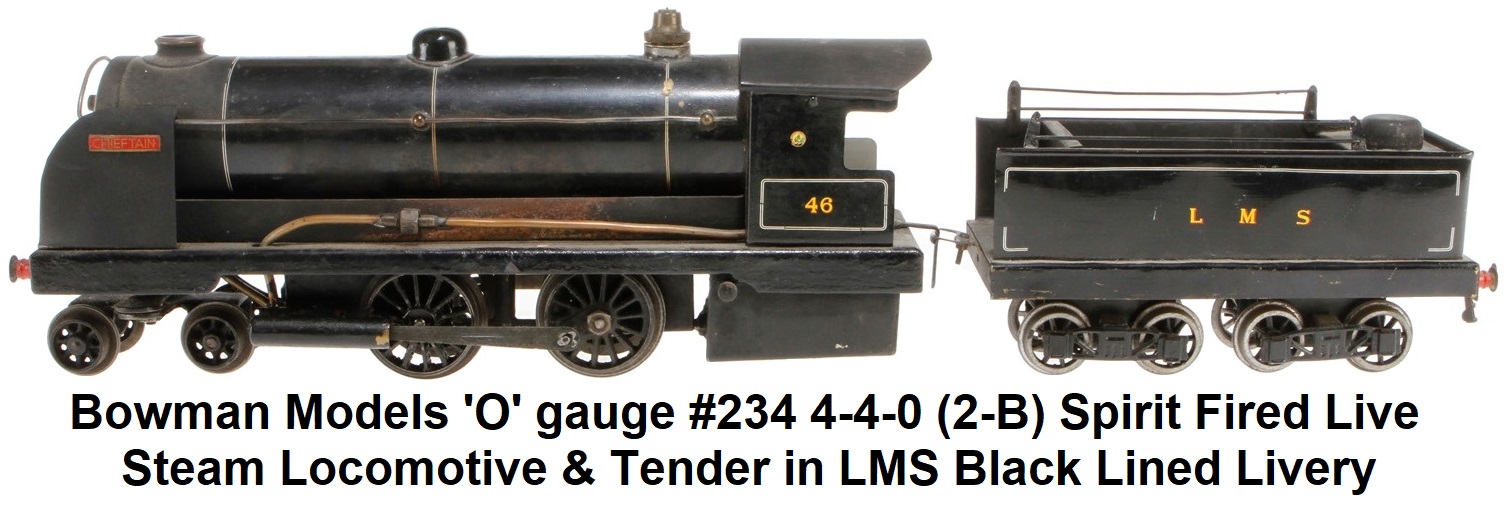 To the eye, the #234 engine appears to be a 4-4-0 wheel arrangement but, in fact, only the rear axle is powered.
The front bogie actually supports the weight of the front of the engine. The central axle is free to rise and fall with the
track and only provides lateral guidance. The flanges on all the wheels are extremely deep and will not run on scale track.
Bowman trains were originally supplied with track having extra deep rails, typical of toy railways of the time. The two
cylinders (3/8" diameter x 7/8" stroke) are single acting oscillating type fed directly from the boiler (2" diam x
8½"), with no control, and exhausting into the chimney. The steam feed follows a rather tortuous route from
the inside of the dome at the top centre of the boiler, out through the rear end of the boiler inside the cab, out to the
sides and forwards along the running boards to the cylinders at the front. The only boiler fittings are a safety valve,
located just in front of the cab, and a level plug on the front end of the boiler. The boiler extends to the front and the
chimney passes through it. The smokebox is just painted on. The fuel tank is situated under the cab and feeds the array of
6 wicks under the boiler. The 6 wheel #250 tender is purely decorative and serves no practical purpose other than to bear
the livery.
To the eye, the #234 engine appears to be a 4-4-0 wheel arrangement but, in fact, only the rear axle is powered.
The front bogie actually supports the weight of the front of the engine. The central axle is free to rise and fall with the
track and only provides lateral guidance. The flanges on all the wheels are extremely deep and will not run on scale track.
Bowman trains were originally supplied with track having extra deep rails, typical of toy railways of the time. The two
cylinders (3/8" diameter x 7/8" stroke) are single acting oscillating type fed directly from the boiler (2" diam x
8½"), with no control, and exhausting into the chimney. The steam feed follows a rather tortuous route from
the inside of the dome at the top centre of the boiler, out through the rear end of the boiler inside the cab, out to the
sides and forwards along the running boards to the cylinders at the front. The only boiler fittings are a safety valve,
located just in front of the cab, and a level plug on the front end of the boiler. The boiler extends to the front and the
chimney passes through it. The smokebox is just painted on. The fuel tank is situated under the cab and feeds the array of
6 wicks under the boiler. The 6 wheel #250 tender is purely decorative and serves no practical purpose other than to bear
the livery.

Geoffrey Bowman Jenkins would often say to his son Paul, that it was one thing to make a flywheel go
round, but quite a different matter for a loc to pull something. He was dismissive of competitors who just made nice
'flywheel turners', which were all speed, but no power. Several of Bowman's stationary engines could lift over a 100 pound
load in a suitably geared Meccano crane, while his #234 locs could pull immense loads on the track. An example of the unique
qualities of Bowman Locos was demonstrated at the 'British Industries Fair' of February 1928, when a standard model #234
tender locomotive could be seen pulling six large coaches, with a total length of the train being 10', without any problems
for days on end. Over the 10 day duration of the exhibition, it actually covered a total distance of 183 miles, the
equivalent of a journey from London to Manchester, without special attention and without appreciable signs of wear. It was
refuelled every 40 minutes (i.e. a journey of 1½ miles). A £5 foreign engine refused to pull half the load and ran 12 minutes
only on one filling. In the highly nationalistic days of the late 1920's and early 1930's Bowman stressed very strongly the
'British' qualities of his models, and how favorably they compared to 'foreign' (read German) toys of that era. The display
of the #234 at the British Industries Fair was such a success that Bowman was overwhelmed with orders from the likes of
Hamleys Toy Shop and Gamages Department stores.
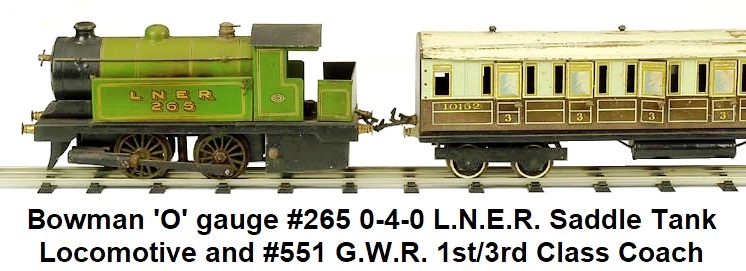 The Bowman Models #265 0-4-0 steam tank locomotive was marketed as a 'Double Power' massive 'O' gauge
engine with a 1 gauge appearance. It is Bowman's second largest loco and came decorated in either L.N.E.R. green livery or
L.M.S. crimson with the #265 appearing on its saddle tank. Literature claimed that it could run for 1½ miles without
stopping. Catalogs and ads also boasted that when used
indoors that the loco would haul 6 to 9 Bowman trucks for 40 minutes non-stop. When used outside, the wicks required
adjustment to a greater height with the result being a shorter run. The locomotive featured a heavy gauge seamless drawn
brass boiler measuring 6¾" x 2", tested to 3 times working pressure. As in the other Bowman steam engines, it was
fitted with the Bowman safety valve, and overflow plug for filling the boiler to the correct level, solid drawn brass
cylinders with a 3/8" x 3/4" stroke, pistons of solid drawn brass with grooved oil rings, scientifically laped out to
perfect fit, special felt oiling pads for lubrication while running, steel frames, turned cast steel wheels with steel
axles, safety type lamp for methylated spirit, with asbestos wicks. The locomotive's overall length measured 10½"
and it weighed 2½ lbs. This loco was designed to operate on 'O' gauge rails with minimum curve radius of 2'. Like all
Bowman engines, it came in a wooden box embossed with the Bowman archer logo, with oil, filling funnel, and detailed
instructions. It was priced at £25, and for the same price was offered as an unbuilt parts kit (without warranty).
The Bowman Models #265 0-4-0 steam tank locomotive was marketed as a 'Double Power' massive 'O' gauge
engine with a 1 gauge appearance. It is Bowman's second largest loco and came decorated in either L.N.E.R. green livery or
L.M.S. crimson with the #265 appearing on its saddle tank. Literature claimed that it could run for 1½ miles without
stopping. Catalogs and ads also boasted that when used
indoors that the loco would haul 6 to 9 Bowman trucks for 40 minutes non-stop. When used outside, the wicks required
adjustment to a greater height with the result being a shorter run. The locomotive featured a heavy gauge seamless drawn
brass boiler measuring 6¾" x 2", tested to 3 times working pressure. As in the other Bowman steam engines, it was
fitted with the Bowman safety valve, and overflow plug for filling the boiler to the correct level, solid drawn brass
cylinders with a 3/8" x 3/4" stroke, pistons of solid drawn brass with grooved oil rings, scientifically laped out to
perfect fit, special felt oiling pads for lubrication while running, steel frames, turned cast steel wheels with steel
axles, safety type lamp for methylated spirit, with asbestos wicks. The locomotive's overall length measured 10½"
and it weighed 2½ lbs. This loco was designed to operate on 'O' gauge rails with minimum curve radius of 2'. Like all
Bowman engines, it came in a wooden box embossed with the Bowman archer logo, with oil, filling funnel, and detailed
instructions. It was priced at £25, and for the same price was offered as an unbuilt parts kit (without warranty).
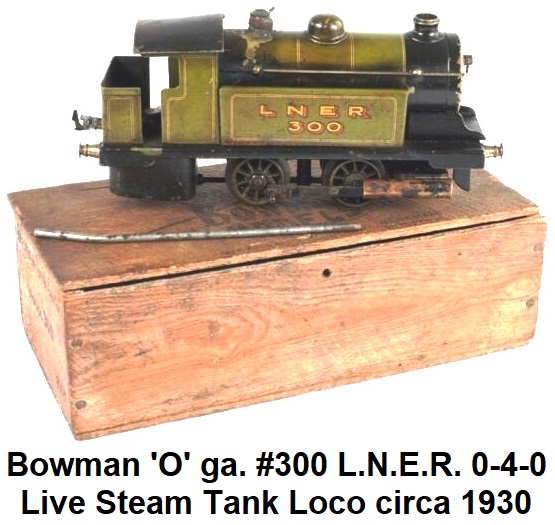 Like the other Bowman locomotives, the Model #300 tank loco was built of solid steel and brass throughout,
fitted with a safety valve, twin single-acting oscillating cylinders, special felt oiling pads that sit behind the pistons
for lubrication while running, turned cast steel wheels on steel axles, and featured a special safety type lamp. It was
'fully guaranteed' and the ads from 1932 claimed that it could run a mile non-stop. It was offered in either L.N.E.R. or
L.M.S. livery for a price of £12/6. The big difference between the #300 and the overscale Bowman models like the #234
and #265 is that it was true 'O' gauge. Because of this, the #300 is compatible with, other manufacturers, such as
Hornby's rolling stock. One other differentiator was that this model had a 5 wick burner. But
similar to the other Bowman locomotives, there is no throttle or any form of speed control. The only way to control the speed
is by adjusting wick height or by selectively capping some of the wicks.
Like the other Bowman locomotives, the Model #300 tank loco was built of solid steel and brass throughout,
fitted with a safety valve, twin single-acting oscillating cylinders, special felt oiling pads that sit behind the pistons
for lubrication while running, turned cast steel wheels on steel axles, and featured a special safety type lamp. It was
'fully guaranteed' and the ads from 1932 claimed that it could run a mile non-stop. It was offered in either L.N.E.R. or
L.M.S. livery for a price of £12/6. The big difference between the #300 and the overscale Bowman models like the #234
and #265 is that it was true 'O' gauge. Because of this, the #300 is compatible with, other manufacturers, such as
Hornby's rolling stock. One other differentiator was that this model had a 5 wick burner. But
similar to the other Bowman locomotives, there is no throttle or any form of speed control. The only way to control the speed
is by adjusting wick height or by selectively capping some of the wicks.
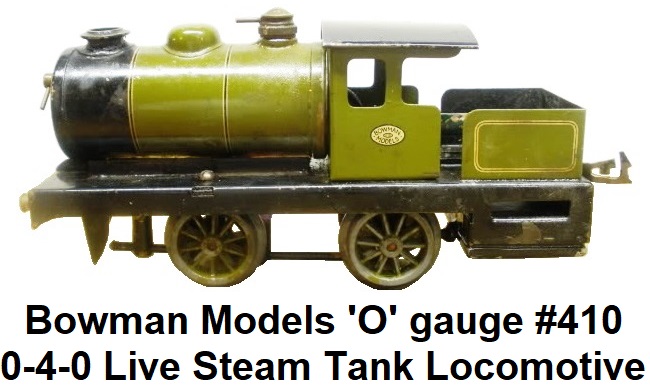 The Bowman Models #410 Live Steam Tank engine was a small and slightly dumpy green 0-4-0 'O' gauge steam-powered
loco, briefly made in 1932 named the Junior Tank Loco. This was the smallest locomotive ever made by Bowman.
In order to achieve the reduction in size (practically a miniature by Bowman standards), the #410 didn't have external
pistons and was instead powered by a single oscillating cylinder mounted inside the cab driving a mazak flywheel geared
to the drive shaft. Again, because it is true 'O' gauge, it is compatible with rolling stock made by other manufacturers.
The #410 was promoted in marketing
materials as a 'New Wonder' and as "One of the most wonderful little steam locos made". Literature also proclaimed that it
could pull 4 or 5 trucks steadily for 15 minutes non-stop, and also stated that because of its special design, this loco
will hold the rails even with a light load. The loco's brass boiler measured 3⅜" × 1½". It featured
a safety valve and overflow plug. Loco length measured 7¼". It came complete in a wooden box and was offered at a
price of £8/6.
The Bowman Models #410 Live Steam Tank engine was a small and slightly dumpy green 0-4-0 'O' gauge steam-powered
loco, briefly made in 1932 named the Junior Tank Loco. This was the smallest locomotive ever made by Bowman.
In order to achieve the reduction in size (practically a miniature by Bowman standards), the #410 didn't have external
pistons and was instead powered by a single oscillating cylinder mounted inside the cab driving a mazak flywheel geared
to the drive shaft. Again, because it is true 'O' gauge, it is compatible with rolling stock made by other manufacturers.
The #410 was promoted in marketing
materials as a 'New Wonder' and as "One of the most wonderful little steam locos made". Literature also proclaimed that it
could pull 4 or 5 trucks steadily for 15 minutes non-stop, and also stated that because of its special design, this loco
will hold the rails even with a light load. The loco's brass boiler measured 3⅜" × 1½". It featured
a safety valve and overflow plug. Loco length measured 7¼". It came complete in a wooden box and was offered at a
price of £8/6.
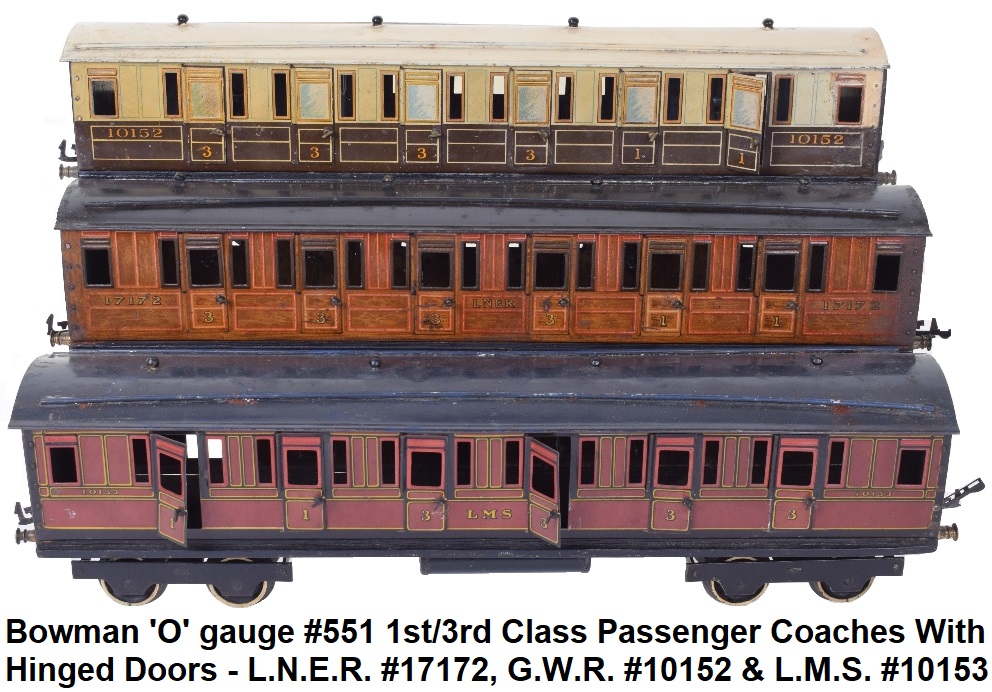 The Bowman Models 1931 catalog description of the #550 & #551 Passenger Coach Models states, "These massive and
substantial coaches have set a new standard for moderate priced rolling stock. They are equally suitable for indoor and
outdoor use, and, on the track, possess that solid smooth-running movement only previously associated with expensive scale
models at several times their price. Constructed solely of wood and steel, there is an entire absence of any "tinny" sound
when running. They are specially designed for use with the large Bowman Locos Models #234 and #265, and their large realistic
appearance and smooth-running properties make a strong appeal to model engineers." These coaches were available in L.N.E.R.,
L.M.S. and G.W. livery. The car body was made of heavy gauge steel plate with opening doors and windows embossed to shape and
mounted on an underbody of hard wood. The car bogies were of special Bowman design ensuring complete freedom in turning
sharp curves. The coach wheels were turned cast iron mounted on steel axles for 'O' gauge (1¼"). Overall length of
the coaches was 16", height 4½", weight 2lbs. Literature claimed the coaches were suitable for curves of 2' radius
and over.
The Bowman Models 1931 catalog description of the #550 & #551 Passenger Coach Models states, "These massive and
substantial coaches have set a new standard for moderate priced rolling stock. They are equally suitable for indoor and
outdoor use, and, on the track, possess that solid smooth-running movement only previously associated with expensive scale
models at several times their price. Constructed solely of wood and steel, there is an entire absence of any "tinny" sound
when running. They are specially designed for use with the large Bowman Locos Models #234 and #265, and their large realistic
appearance and smooth-running properties make a strong appeal to model engineers." These coaches were available in L.N.E.R.,
L.M.S. and G.W. livery. The car body was made of heavy gauge steel plate with opening doors and windows embossed to shape and
mounted on an underbody of hard wood. The car bogies were of special Bowman design ensuring complete freedom in turning
sharp curves. The coach wheels were turned cast iron mounted on steel axles for 'O' gauge (1¼"). Overall length of
the coaches was 16", height 4½", weight 2lbs. Literature claimed the coaches were suitable for curves of 2' radius
and over.
Bowman offered 4 different 'O' gauge goods rolling stock in wood and steel. These were the #661 open
wagon, #662 brake van, #663 oil wagon and #664 timber wagon. The goods wagons featured turned cast iron wheels and steel
axles. Each car measured 7¼" in length and sold in the £5/9 to £9/6 price range. These freight wagons
are rare and very difficult to find these days. As a result, collectors covet them closely, and they oftentimes sell for
more than the locomotive models, when located.
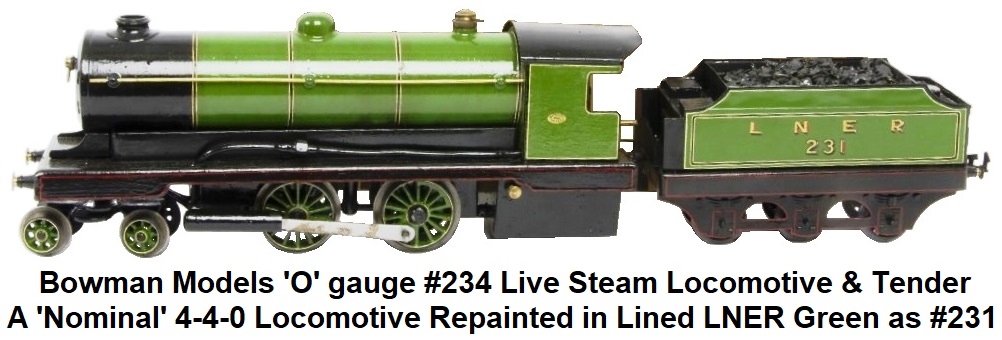 Advertisements claimed that Bowman track was capable of being stood on, like real railway lines.
Bowman's brass 2-rail track was suitably heavy-duty, with creosoted wooden sleepers that had a small central hole to
allow the track to be screwed or nailed down. The coating of the sleepers and the use of brass rail made the track
water proof. The Bowman 'O' gauge track was offered in 2' lengths as straights and curves. Points for straight run,
left or right hand turnout in 2' (£9/6) and 4' (£12/6) radius were also available, sold in pairs. The
switches were simple and self locking and the stock rails were swaged to provide cover for the point of switch.
Advertisements claimed that Bowman track was capable of being stood on, like real railway lines.
Bowman's brass 2-rail track was suitably heavy-duty, with creosoted wooden sleepers that had a small central hole to
allow the track to be screwed or nailed down. The coating of the sleepers and the use of brass rail made the track
water proof. The Bowman 'O' gauge track was offered in 2' lengths as straights and curves. Points for straight run,
left or right hand turnout in 2' (£9/6) and 4' (£12/6) radius were also available, sold in pairs. The
switches were simple and self locking and the stock rails were swaged to provide cover for the point of switch.
Bowman offered 2 different complete model railway sets. The Express Passenger Set #23455 featured
a #234 4-4-0 steam loco, #250 tender, 2 #551 coaches, an oval of track, 3 wick covers and spare wicks. Packed in a strong
wood box it sold for £75. The Goods Train Set #26566 included a #265 steam tank loco, #661 open wagon, #662 brake van,
#663 oil wagon, #664 timber wagon, an oval of track, 3 wick covers and spare wicks. It too was packed in a wood box and
sold for £60.

The Bowman name was not to disappear from live steaming. After World War Two, P.M. Nash's Piece Parts and
Assemblies Ltd. company needed to find a new market now that they were no longer getting a steady stream of contracts related
to war work, and acquired the Bowman Models name and trademark. Bowman was reincarnated during the postwar boom, operating
out of Luton, Bedfordshire. The new company produced their own range of Meccano-compatible steam engines and other products
similar to those in the original Bowman Models range. While the company did use the red archer emblem from the original
Bowman firm, there does not appear to be any other direct connection between the two companies. Geoffrey Bowman Jenkins'
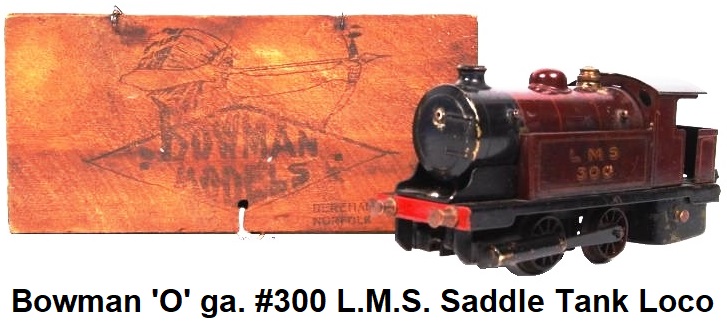 family stated that this firm was operated by Captain Bernard A. Smart, a retired British pilot and cousin of Geoffrey's.
However, to most people knowledgeable of Bowman Models history and products, the name reflects only Geoffrey Bowman
Jenkins' original company and its accomplishments.
family stated that this firm was operated by Captain Bernard A. Smart, a retired British pilot and cousin of Geoffrey's.
However, to most people knowledgeable of Bowman Models history and products, the name reflects only Geoffrey Bowman
Jenkins' original company and its accomplishments.
The fact that many Bowman Models have survived today is a testament to their engineering and quality
of raw materials. Many hobbyists and collectors have chosen to restore or repaint their locomotives, as use of live steam
engines leveraging spirit firing generates great amounts of heat and tends to take its toll on paint finishes. Many collectors
leave their Bowman Models on the shelf for display only, in fear of damaging the finish. However, those that continue to
fire and operate these engines greatly appreciate and admire the pulling power and speed that can be attained from such a
simple device.
